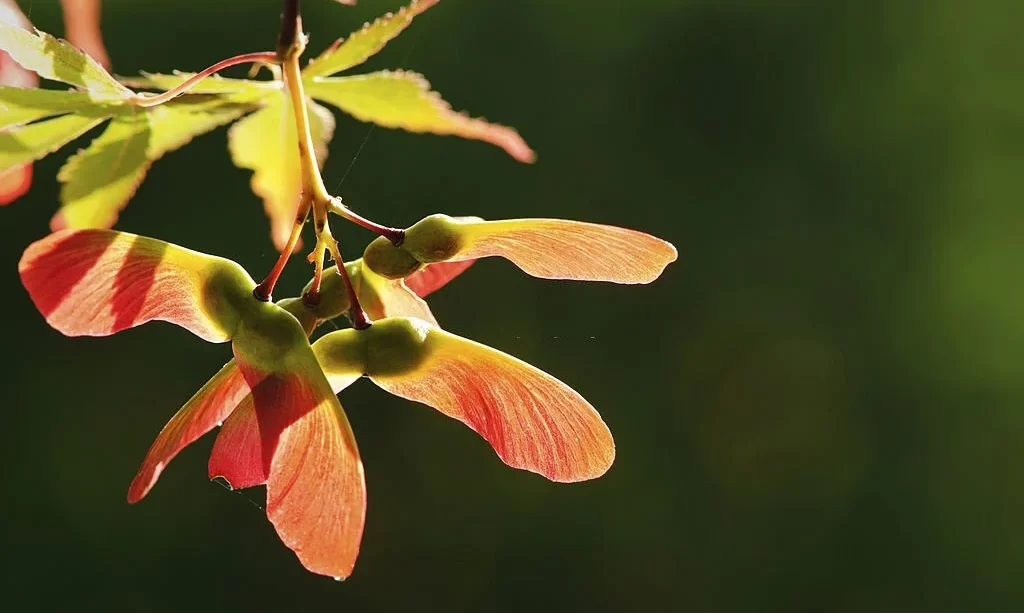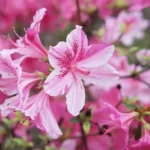Helicopter seeds are a whimsical wonder of the natural world, capturing the imagination of many with their graceful descent from the sky. These seeds, with their spinning flight, are associated with specific tree species that possess a unique form of seed dispersal. In this article, we delve into the captivating world of trees with helicopter seeds. We begin our exploration with the most iconic of them all—the maple tree.
- FLOATING CLOUDS JAPANESE MAPLE IS TRULY UNIQUE WITH STRONG VEINING OVERLAID BY VARIOUS COLORS!
- UKIGUMO APPEARS TO E FLOATING ON CLOUDS AS THE NAME SUGGESTS!
- UKIGUMO HAS EVER-CHANGING FOLIAGE, JUST LOOK AT THE IMAGES… YES THIS IS THE SAME TREE!
- WHEN UKIGUMO ARE YOUNG THEY LOOK LIKE AN ORDINARY GREEN LEAVED JAPANESE MAPLE FOR THE FIRST FEW YEARS
- REACHES 5-6 FEET AT MATURITY SHIPPED IN IT ORIGINAL WITH SOIL HARDY ZONE 5-8
The Maple Tree
The maple tree, renowned for its stunning autumn foliage, is perhaps the most famous bearer of helicopter seeds. This majestic tree belongs to the genus Acer and boasts over 128 species distributed across the Northern Hemisphere. However, it’s the sugar maple (Acer saccharum) and the silver maple (Acer saccharinum) that are most recognized for their distinctive samara seeds, often referred to as “maple keys” or “maple helicopters”.
Maple seeds are a marvel of natural engineering. Each seed features a pair of winged structures, known as samaras, which develop as the seeds mature. These samaras are arranged in a V-shape, with a single seed at the center. When released from the tree, they catch the wind and spin gracefully through the air, resembling miniature helicopters in flight. This unique adaptation allows maple seeds to travel considerable distances away from the parent tree.
Maple trees play a vital role in forest ecosystems, providing habitat and sustenance for various wildlife species. Additionally, they are celebrated for their hardwood timber, used in the crafting of furniture, flooring, and musical instruments. Beyond their practical applications, maple trees hold cultural significance in many regions and are associated with the beauty of changing seasons.
As we delve deeper into the world of trees with helicopter seeds, it’s important to recognize the maple tree’s central role in this intriguing natural phenomenon. Its seeds, carried by the wind, have delighted generations with their distinctive flight, leaving an indelible mark on our collective appreciation of the wonders of nature.
The Seed Structure
To understand the enchanting flight of helicopter seeds, it’s essential to dissect their unique seed structure. Let’s explore the anatomy of these remarkable seeds:
Maple seeds, like other helicopter seeds, consist of three primary components:
- Seed: At the center of the helicopter-like structure lies a single seed. This seed contains the genetic material necessary for the growth of a new tree. It’s encased in a protective outer shell.
- Wings (Samaras): The wings, often referred to as samaras, are thin, flattened structures attached to the seed. These wings are the secret behind the seeds’ graceful descent. As the seed falls from the tree, the samaras catch the wind, causing the seed to spin and glide. This spinning action slows the seed’s descent, allowing it to travel farther from the parent tree.
- Stem: Connecting the seed to the wings is a slender stem or stalk. This stem serves as the anchor point, allowing the seed to remain centered within the spinning samaras.
The ingenious design of these seeds enhances their chances of successful dispersal. As they twirl through the air, they can be carried by the wind to new locations, increasing the likelihood of finding suitable conditions for germination and growth.
- STUNNING ORANGE AND RED NEW SPRING GROWTH IS A SIGHT TO BEHOLD!
- CHANGING TO LIME-YELLOW EDGED IN ORANGE AND SLOWLY TO LIGHT GREEN FOR THE SUMMER
- THIS DWARF JAPANESE MAPLE ONLY REACHES 8-10 FEET TALL!
- EVERYONE WHO COLLECTS JAPANESE MAPLES EITHER HAS OR WANTS ONE OF THESE BEAUTIES
- 2 – YEAR TREE – REACHES 10 FEET AT MATURITY – SHIPPED IN A CONTAINER WITH SOIL – ZONE 5-8
Other Trees with Helicopter Seeds
While maple trees are the most iconic bearers of helicopter seeds, they are not the only ones to possess this captivating adaptation. Let’s explore some other tree species that produce similar seeds:
- Ash Trees: Ash trees (genus Fraxinus) are known for their samara seeds, which have a winged structure similar to maple seeds. These seeds help ash trees disperse their offspring and colonize new areas.
- Elm Trees: Elm trees (genus Ulmus) produce seeds known as samaras or “elm seeds” that are also equipped with wings. These seeds aid in the natural propagation of elm trees.
- Hornbeam Trees: Hornbeam trees (genus Carpinus) produce distinctive hop-like fruits, also called samaras. These fruits have a unique appearance and function as wind-dispersed seeds.
- Pine Trees (Ponderosa Pine): Although not true helicopter seeds, certain pine trees, like the ponderosa pine (Pinus ponderosa), produce seeds with a wing-like structure. These seeds, known as pine nuts, can be dispersed by wind to some extent.
- Douglas Fir Trees: Douglas fir trees (Pseudotsuga menziesii) also produce winged seeds, allowing for wind dispersal.
These trees share the fascinating adaptation of helicopter-like seeds, aiding in the dispersal of their genetic material. Each species has its unique variations in seed structure and ecological role, contributing to the rich tapestry of nature’s wonders. As we explore these trees and their seeds, we gain a deeper appreciation for the intricate mechanisms that drive the life cycles of these remarkable species.
- Each Big Pack Contains 100 Seeds
- Botanical Name : Pseudotsuga menziesii , California
- Common Name : Douglas Fir (California)
- Height : 40 – 220 ft
- Spread : 80 ft
Seed Dispersal Strategies
Helicopter seeds, with their spinning flight, represent a remarkable seed dispersal strategy employed by certain tree species. Let’s delve into the significance of this strategy and how it contributes to the survival and proliferation of these trees:
Seed dispersal is a critical aspect of a tree’s life cycle. It ensures that the offspring have the opportunity to establish themselves in new locations, away from the parent tree, where they can access necessary resources and avoid competition for light, nutrients, and water.
Helicopter seeds, characterized by their aerodynamic design, employ wind as their primary mode of dispersal. Here’s how this strategy works:
- Wind Dispersal: When the seeds are released from the parent tree, their samaras act like miniature aircraft. The wings catch the wind and generate lift, causing the seeds to spin and glide. This spinning motion slows their descent, allowing them to travel considerable distances from the parent tree.
- Increased Range: The spinning action extends the range of dispersal, helping seeds reach locations that might be more favorable for germination and growth. This mechanism is particularly advantageous in densely populated forests or areas with limited open space.
- Reduced Competition: By spreading their offspring far and wide, trees with helicopter seeds reduce the risk of competition with their own seedlings. This strategy maximizes the chances of survival for the next generation.
- Diverse Habitats: Wind dispersal enables these seeds to explore a variety of habitats, increasing the likelihood of finding suitable conditions for germination. Some seeds may land in open areas, while others could end up in sheltered spots, expanding the tree’s ecological range.
- 100% Pure Grade A Maple Syrup (made from the sap of maple trees)
- Our maple syrup has a delicious tasting, full-bodied dark, robust maple flavor
- Delicious on pancakes, waffles, hot and cold cereals, ice cream, yogurt and fruit. Try it in your favorite beverage. Use as a glaze on meats and vegetables. Excellent pure substitute for sugar in baked goods.
- Your purchase supports local family sugar makers in Minnesota, Wisconsin and Michigan
- No artificial ingredients or preservatives. Gluten Free, Vegan, Paleo-friendly. Full of vitamins, minerlas and antioxidants. Maple syrup has a low glycemic index.
Human Uses and Fun Facts
Beyond their ecological role, trees with helicopter seeds have practical and cultural significance for humans:
- Wood Products: Maple trees, renowned for their helicopter seeds, are prized for their hardwood. Maple wood is used to create a wide range of products, including furniture, flooring, cabinetry, and musical instruments.
- Syrup Production: Some maple species, such as the sugar maple (Acer saccharum), are tapped for their sap, which is processed into maple syrup—a beloved and sweet treat.
- Cultural Symbolism: Maple leaves, often associated with maple trees, are a symbol of Canada and featured prominently on the country’s flag.
- Botanical Interest: Trees with helicopter seeds, like maples, pique the curiosity of botanists and nature enthusiasts alike. Their unique seed dispersal mechanism has inspired awe and wonder for generations.
Conclusion
In concluding our exploration of trees with helicopter seeds, we’ve uncovered a fascinating natural phenomenon—one that combines elegant design with effective seed dispersal strategies. These trees, particularly the maple, have captured the human imagination with their distinctive seeds and stunning foliage.
From an ecological perspective, helicopter seeds play a crucial role in sustaining forest ecosystems. They ensure the continuity of tree species and contribute to the diversity of habitats by colonizing new areas.
As we marvel at the twirling descent of helicopter seeds, we gain a deeper appreciation for the intricate web of life in our natural world. These seeds remind us that even the smallest natural wonders can have a profound impact on the survival and proliferation of remarkable tree species. So, the next time you encounter a maple tree releasing its helicopter seeds, take a moment to celebrate the ingenious mechanisms of nature that have been captivating us for generations.







